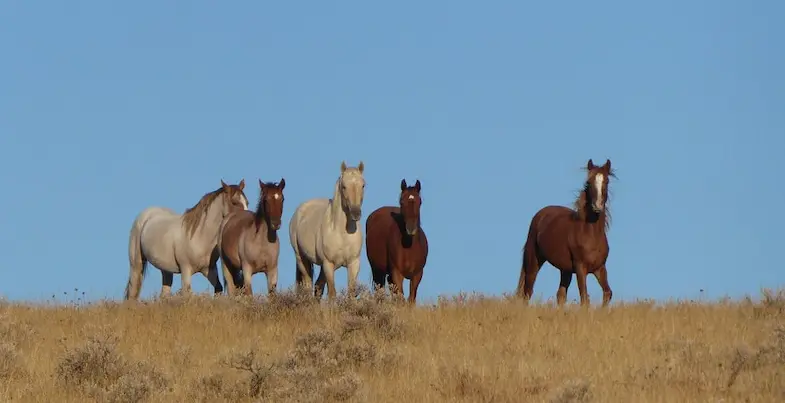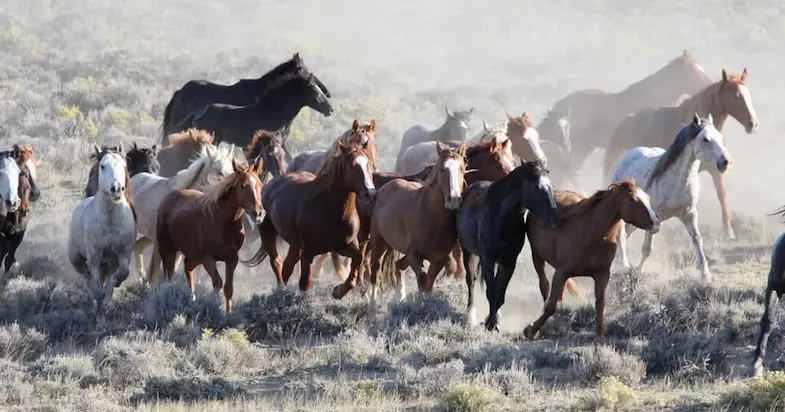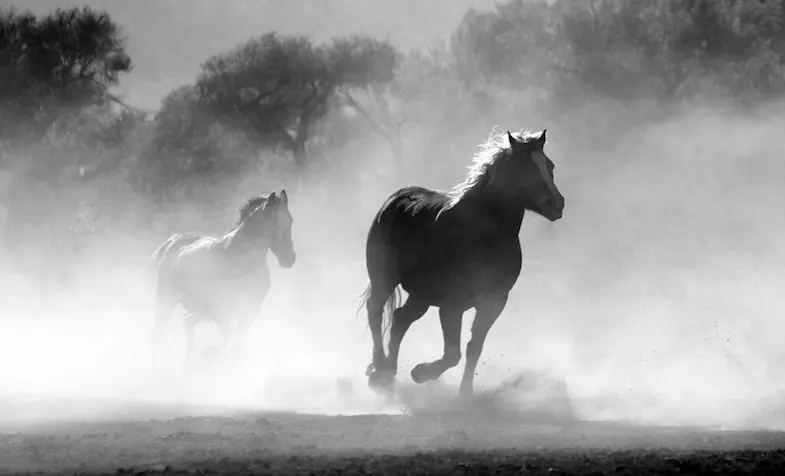I was watching a documentary the other day about wild horses and as soon as a captured horse was released he’d rush off seemingly knowing exactly where he was going, even if he’d been released in unfamiliar territory. This started me thinking about if horses can independently find their way home. I always thought they could but wanted to find out for sure so decided to look into it, I was amazed at what I found, not just about whether they can, but how they actually do it.
Can horses find their way home? The simple answer is that yes, horses can absolutely find their own way horse but what may surprise you is that they can even do this if they were transported away from the yard and don’t know where they are.
If you ride away from the yard a lot you’ll probably have noticed that your horse seems to know instinctively when you’re approaching home, even if you’ve taken a completely different route. While some people may argue that a horse is picking up on subtle queues from the rider, any rider that’s fallen off and had their horse rush off home will tell you this isn’t the case, especially when they’ve had to walk for miles only to discover their horse has already made it back to the yard and is waiting at the gate for them.
Recent studies have also shown that, while horses may notice subconscious changes in their rider’s behavior, they in fact have their own built-in GPS system which helps to guide them home and back to the herd. The important question though is how do they do it?
How do horses find their way home?
Horses use two different types of navigation to help them find their way, mind mapping, and compass orientation, depending on where they are.
Mind mapping
When a horse is in familiar surroundings they use mind mapping to help them find their way around. Just as we use a map with graphic landmarks, horses remember visual landmarks to help them get their bearings. This evolved from their wild ancestors who needed to remember where they could find food and water within their vast habitat. The use of visual landmarks or cues would help the horse to picture where everything was, for example, they may remember that there was a good watering hole behind a bush that was after a line of trees.
As well as visual mapping you might be surprised to know that they can also use scent mapping and regularly leave a scent trail in the form of droppings. If you’ve noticed your horse leaving a dropping trail while you’re out riding the chances are he’s doing it so that he can use the smell to help him find his way home. This scent mapping can also help horses to follow the same path as each other, even if they do so on separate days.
Compass orientation
The problem with mind mapping is that it only works if you know the area or if you can follow another horse’s scent. If a horse is in a strange place he can’t rely on his memory to help him find his way home which is where compass orientation comes into play. It works because horses are able to tap into the Earth’s magnetic fields and can use them to navigate an unknown route home.
While it’s not known exactly how horses (along with bats, birds, salmon, and other mammals) do this, a recent study demonstrated just how good they are at it. The study took a number of horses and placed them in separate locations up to 50 miles (80 km) away, every single one of those horses found their way home without any help or guidance. A similar study, this time at a distance of between 9 to 15 miles (15 to 25 km), showed similar results, although this time some of the horses had lightweight magnets hung around their withers. Those horses weren’t able to find their own way home while the horses without the magnets did pretty quickly.
Its also worth noting that research carried out by Prof. Dr. Sabine Begall from University Duisburg-Essen in Germany showed that horses, just like cattle and deer, will stand in the direction of the magnetic fields. Her team used Google Earth to count over a thousand horses in hundreds of different locations around the globe. They then checked which way the horse was facing with the direction of the magnetic field and found that ALL of the horses were standing in the direction of the fields, with two-thirds of them standing towards the magnetic North Pole while the rest were facing the southern magnetic pole.
Are some horses better than others at finding their way home?
While all horses have the ability to find their own way home, just like people, there will always be some that are better at it than others. This is particularly evident in breeds such as the Icelandic Horse, these horses are regularly turned loose after a long day (or days) of riding, the horses are then left to find their own way home which they always do.
It’s not specific to certain breeds though and there will always be some horses within every breed that are better or worse at navigating than others.
Can a horse carrying an injured rider still find its way home?
Any western movie will show a horse carrying an injured rider away to the safety of their home range but this, for once, isn’t something Hollywood has made up it’s actually truer than you might think. As long as we’ve been riding horses they’ve been looking after us, and not just when we’re hurt.
Long before we had cars and bikes to take us home after a long evening drinking people would regularly stagger out of the bar and ‘fall’ onto their horse, only for the horse to carry them home without ever being asked.
Of course, if you wanted the horse to take an injured or incapacitated rider to a different location you would have to take the horse there yourself.
Why don’t abandoned horses find their way home?
One thought that came into my mind while researching this article was why do horses that have been abandoned never return home and while no studies have been carried out into this there are a few theories. Some horses that are abandoned though are sadly tied to where they’ve been left so can’t find their way home but for others, there are two main reasons.
Most people that abandoned horses weren’t looking after them properly in the first place and were often keeping them in poor conditions with little or no contact from other horses, sometimes even mistreating them. I don’t know about you but if I was one of those horses I wouldn’t want to go back there either, I’d rather take my chances in the wild.
The problem with using compass orientation though is that the signal from the magnetic field can be interfered with and interrupted, especially when there are strong power lines nearby. These power lines give off their own magnetic field (known as an electromagnetic field or EMF) which can confuse the Earth’s own signals. This can result in a horse not knowing where to go and sadly ending up lost. If this happens though the horse will likely look for other horses and try to join the safety and security of that herd.
I hope you found this article helpful. If you did I’d be grateful if you could share it please as it would really help me.
Recommended products
Over the years I have tried hundreds of different horsey products, from various blankets and halters to different treats. Some I’ve loved, others I’ve hated but I thought I’d share with you my top all-time favorite products, the ones I never leave the yard without. I’ve included links to the products (which are in no particular order) that I really think are great.
- Horse Knots by Reference Ready – If you’re like me and enjoy pocket reference guides then you’ll love this knot tying guide. These handy cards can easily fit in your pocket or attach to the saddle for quick reference. They’re waterproof, durable and are color coded to make them easy to follow.
- Mane ’n Tail Detangler – Even if you never show your horse you’ll need to detangle his tail from time to time (and possibly his mane too) which is always a challenging chore! I’ve found that if I run a little bit of detangler through my horse’s tails every few days it stops them from getting matted up and makes combing them easy, even if they’re coated in mud. I don’t know if I should admit to this or not but it also works wonders on my hair.
- TAKEKIT Pro clippers – Over the years I’ve tried a lot of different clippers and while some were obviously better than others I found these to be by far the best. They are heavier than a lot of other clippers but for me, that’s a good thing, it makes them feel more sturdy and hardwearing. On top of that they have a range of speeds so are just as good for clipping your horse’s back as they are his face. I also like the fact that they come in a handy carry case but that’s not for everybody. The company that makes them is super good and incredibly helpful too, a real bonus these days. The only thing I wasn’t keen on was the fact that it doesn’t come with any oil, but that’s not a major problem as it’s not difficult to buy lubricant.
- Shire’s ball feeder – There are so many boredom buster toys out there but I like to use these every day, regardless of whether or not my horses are bored. I find that it helps to encourage my horses to problem solve by rewarding them with treats (or pieces of fruit) but it also mimics their natural grazing behavior which helps to keep them calm and de-stressed.
- Horse safe mirror – This is a strange one that many people are surprised about but I like to put horse safe mirrors in the trailers as well as in the quarantine stalls. It helps to prevent the feeling of isolation by giving the impression of other horses being around. Being herd animals horses can get extremely stressed when they feel that they’re on their own but with these stick-on mirrors, they believe that at least one other horse is with them.
- Rectal thermometer – I know this isn’t glamourous at all but it’s vital for your horse’s well-being to be able to check their temperature and a rectal thermometer is the easiest way of doing this which is why I’ve added it to the list.
Shopping lists
I’ve also put together a few shopping lists of essential items that I’ve found helpful over the years. I’ve broken the lists down into different categories rather than put everything in one massive list 😉





